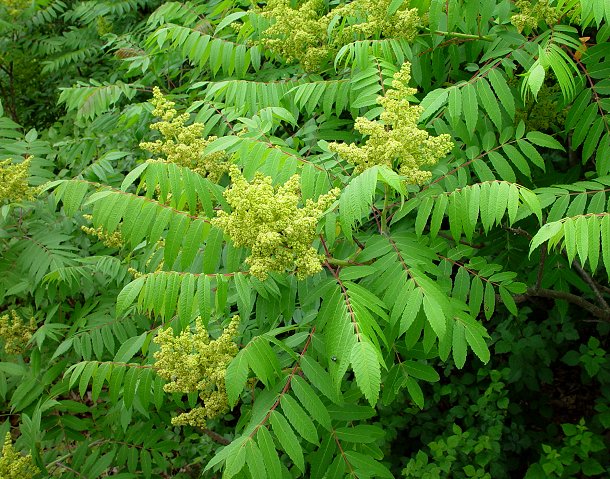Rhus glabra L.
Smooth Sumac

Native
CC = 1
CW = 5
MOC = 72
© DETenaglia
Rhus glabra L.Smooth Sumac | |
 |
Native CC = 1 CW = 5 MOC = 72 |
© DETenaglia |
|
Family - Anacardiaceae Habit - Large shrub or rarely small tree, usually dioecious. Stems - Ascending, to 5 m, branched. Young branches glabrous, glaucous (but note that inflorescence branches usually are sparsely hairy), the older branches usually with prominent lenticels.
Leaves - Alternate, pinnately compound with 11-21 leaflets, the petiole 6-11 mm long, glabrous, reddish purple, the rachis not winged. Leaflets 5-13 cm long, 1.5-3.0 cm wide, lanceolate to elliptic-lanceolate, sessile or very short-stalked, the margins toothed, the upper surface dark green, glabrous, shiny, the undersurface light green, glabrous, glaucous.
Inflorescence - Terminal, dense, ovoid panicles, 10-25 cm long, 5-10 cm wide.
Flowers - Sepals 5, 1.6-2.0 mm long, narrowly ovate, sharply pointed at the tip, fused at the base. Petals 5, 2.0-2.5 mm long, oblanceolate, rounded at the tip, greenish yellow, sparsely hairy on the inner surface. Staminate flowers with the stamens 5, the anthers ovoid, usually shorter than the filaments. Pistillate flowers with the styles 3, appearing terminal, equal in length or nearly so, short, sometimes fused toward the base. Ovary with 1 locule.
Fruits - Fruits 4-6 mm long, 4-5 mm wide, somewhat flattened, red, with dense, minute, stout, red glandular hairs.
Flowering - May - July. Habitat - Forest openings, open woods, prairies, fencerows, roadsides, railroads. Origin - Native to U.S. Lookalikes - R. copallinum, R. typhina. Other info. - This shrub is common throughout Missouri and the eastern half of the continental U.S. and some regions farther west. It is present to some extent in every state in the contiguous 48 and also ranges into Canada and Mexico. It is an easily recognized species by virtue of its compound leaves with toothed leaflets. Unlike R. copallinum, the leaf rachis is not winged, and unlike R. typhina (which is rare in Missouri), the branches are glabrous.
Traditionally this species was used heavily by natives to treat numerous ailments. The leaves were once boiled and made into a tea to help remedy asthma, diarrhea, and dysentery. A root tea was used as a diuretic. The berries of this plant can be steeped in water to prepare a pleasantly tart beverage not unlike lemonade. The tea is caffeine-free but rich in Vitamin C. It is best to use cold water to brew this "sumac-ade," as hot water releases bitter tannins. Provided that ripe, deep red berries are used, there is no danger of confusing these plants with poison sumac, which has whitish berries. The dried fruits of some sumac species are ground and used as a sour seasoning in Middle Eastern cuisines. Photographs taken at Dave Rock Conservation Area, St. Clair County, MO., 6-7-03 (DETenaglia); also at Busch Wildlife Area, St. Charles County, MO, 8-10-2007 and 6-12-2009, Klondike County Park, St. Charles County, MO, 5-29-2017, and Illiniwek Village SHS, Clark County, MO, 7-8-2017 (SRTurner). |